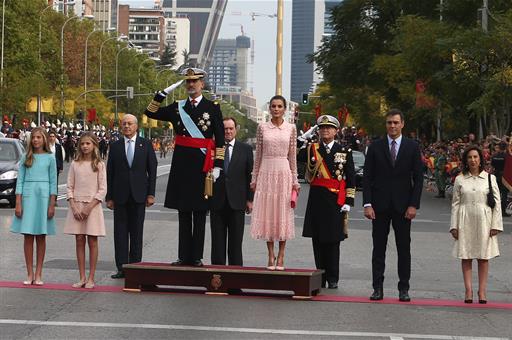Representatives from the Lebanese, Malian, Mauritanian and Senegalese armies also took part.
The King and Queen of Spain, as well as the Princess of Asturias and Infanta Sofía, were accompanied by the Acting President of the Government, Pedro Sánchez, the Speakers of the Lower and Upper Houses of Parliament, the Acting Minister for Defence, Margarita Robles, and other acting ministers and military, regional and local authorities.
Furthermore, the event was also attended by the United Nations Under-Secretary-General for Peace Operations, Jean-Pierre Lacroix, as a tribute by this organisation to the contribution from Spain to its peacekeeping missions. Spanish servicemen and women are currently serving on UN peacekeeping missions in Colombia and Lebanon.
To celebrate 30 years of Spanish overseas operations, the event was attended by a number of military servicemen decorated for their participation on international missions.
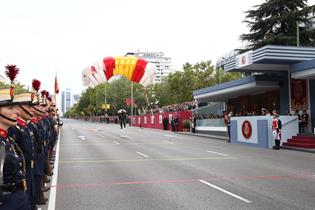 Pool Moncloa/Fernando CalvoAttendance at the event by executives from various major institutions in Spain should also be highlighted, such as the Cervantes Institute, the Spanish National Transplant Organisation, the Mine Rescue Brigade and Cáritas Española, as well as various universities.
Pool Moncloa/Fernando CalvoAttendance at the event by executives from various major institutions in Spain should also be highlighted, such as the Cervantes Institute, the Spanish National Transplant Organisation, the Mine Rescue Brigade and Cáritas Española, as well as various universities.
The parade began a little after 11 in the morning with a parachute jump over Plaza de Lima, where the Royal Grandstand was located. Members of the Paratrooper Brigade carried the national flag for a descent from 1,500 metres, which was then raised in an official ceremony.
This was followed by a ceremony in tribute to those who have given their lives for Spain, with attendance by the 23 standards and pennants of the units deployed on operations and during which the hymn entitled "La muerte no es final" [Death is not final] was performed by the soprano from Guipúzcoa, Ainhoa Arteta. In traditional honour, this tribute concluded with a fly-over by the Patrulla Águila [Eagle Patrol] leaving a trail in the colours of the Spanish flag.
Air display
The event continued with an air display involving 76 aircraft, including the F-18, the Eurofighter and F-5B fighters from the Spanish Air Force and Harrier AV-8B fighters from the Spanish Navy, followed by an A400M refuelling plane simulating a refuelling operation with two fighters.
The transport and tactical aircraft that flew over the Paseo de la Castellana included the A400M, C-130, C-295 and C-212, as well as the A310, Falcon 900 and TR-20 units, followed by maritime surveillance aircraft that included the P-3, D-4 VIGMA, a CN-295 from the Aircraft Group of the Spanish Guardia Civil and a C-212 from the Customs Surveillance Service. The formation ended with "fire-fighting" Canadair aircraft.
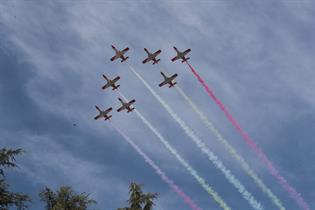 Ministerio de DefensaThe next group to fly over the Paseo de la Castellana from south to north was made up by Superpuma and S.76C helicopters from the EA, SH-60B and AB-212 helicopters from the Spanish Navy, and Cougar, NH-90, Chinook and Tiger helicopters from the AirMobile Forces of the Spanish Army, as well as Dauphin and EH-35 helicopters from the Spanish Guardia Civil.
Ministerio de DefensaThe next group to fly over the Paseo de la Castellana from south to north was made up by Superpuma and S.76C helicopters from the EA, SH-60B and AB-212 helicopters from the Spanish Navy, and Cougar, NH-90, Chinook and Tiger helicopters from the AirMobile Forces of the Spanish Army, as well as Dauphin and EH-35 helicopters from the Spanish Guardia Civil.
In addition, the air display of rotary blade vehicles also included Cougar and EC-135 emergency support helicopters assigned to the Emergency Military Unit (Spanish acronym: UME) and EC-225 helicopters from the Maritime Rescue Service (an entity managed by the Ministry of Public Works), ending with the EC-135 helicopters from the Aerial Resources Service of the Spanish National Police Force (which is celebrating its 40th anniversary this year) and a Dauphin from the Spanish Tax Office.
The air display concluded with a fly-over by the Patrulla Águila, which includes two female officers.
More than 150 vehicles
In turn, the ground parade began with a mechanised component made up of 102 vehicles that included veteran representatives from the Spanish Armed Forces and the Spanish Guardia Civil, personnel with disabilities and volunteer reservists.
This was followed by a parade of patrol vehicles deployed on missions in Afghanistan and Iraq consisting of RG-31 and VAMTAC units in various configurations, as well as support vehicles such as cranes and explosive device clearing vehicles.
Various special vehicles from the Spanish Army followed these, including a Pizarro infantry combat vehicle currently deployed in Latvia as part of NATO Operation "Forward Presence". Behind these vehicles came various Engineer resources from the 11th Specialist Regiment, a unit that is now 175 years old.
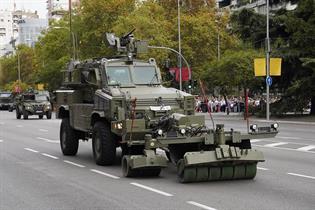 Ministerio de DefensaThe parade also included mechanised units and special vessels from the Spanish Navy, as well as various vehicles from the Spanish Air Force and special vehicles from the Emergency Military Unit, including several that recently supported the situation following the floods in Murcia and Alicante, as well as the removal of common water hyacinth (camalote) from the River Guadiana.
Ministerio de DefensaThe parade also included mechanised units and special vessels from the Spanish Navy, as well as various vehicles from the Spanish Air Force and special vehicles from the Emergency Military Unit, including several that recently supported the situation following the floods in Murcia and Alicante, as well as the removal of common water hyacinth (camalote) from the River Guadiana.
The parade of mechanised units continued with equipment from the Spanish Guardia Civil, including vehicles from the Rapid Response Force that is celebrating the 25th anniversary of its first international mission this year. They were accompanied by patrol and special vehicles from the Spanish National Police Force and Maritime Rescue Service.
The motorised parade this year also included various resources from regional and local agencies forming part of the National Civil Protection System, including resources from the Emergencies and Security Group of the Regional Government of the Canary Islands, the Regional Governments of Castile-La Mancha, Galicia and Madrid, and Madrid City Council.
Units on foot
Once the mechanised vehicles had passed, the marching parade began in front of Their Majesties the King and Queen of Spain, with four groups from the various branches of the Army, Navy and Spanish Guardia Civil.
The parade was led by the Flag of the Royal Guard and the flags of Lebanon, Mali, Mauritania and Senegal, countries invited to take part in the parade and where Spain currently has troops deployed on various missions.
The parade continued with the flags of the units participating in the event, led by the flag of the 67th Tercio Viejo de Sicilia Infantry Regiment, which is celebrating the 300th anniversary of its creation in San Sebastian, and the flag of the Juan Sebastián de Elcano training vessel in commemoration of the fifth centenary of the first trip round the world.
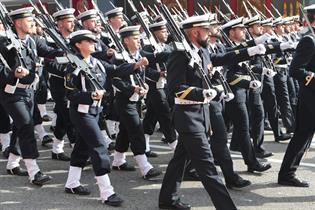 Ministerio de DefensaThese were followed by the standards of the units taking part in international missions, ahead of 119 servicemen from the armies of Lebanon, Mali, Mauritania and Senegal, as well as a company in period uniform of students from the 'Duque de Ahumada' Young Guardia Civil Officers School, which held an honorary place in the parade this year due to the 175th anniversary of the creation of the Spanish Guardia Civil.
Ministerio de DefensaThese were followed by the standards of the units taking part in international missions, ahead of 119 servicemen from the armies of Lebanon, Mali, Mauritania and Senegal, as well as a company in period uniform of students from the 'Duque de Ahumada' Young Guardia Civil Officers School, which held an honorary place in the parade this year due to the 175th anniversary of the creation of the Spanish Guardia Civil.
The battalions of students, officers and non-commissioned officers from the Spanish Army, Air Force, Navy, Central Defence Academy and Guardia Civil were followed by two groups representing various units from the Spanish Armed Forces, some of them in period uniform, as well as the Emergency Military Unit.
The marching parade ended with those units that march using specific techniques, specifically the '2nd Duque de Alba' unit of the Spanish Legion based in Ceuta and the Tabor Alhucemas (battalion) of the 52nd Melilla Regulars Group (regiment), the most decorated unit in the Spanish Army.
The parade continued with horseback units, with a section of Horseback Artillery from the Royal Battery followed by the Sabre Squadron of the Reserve and Security Group of the Spanish Guardia Civil.
The celebration was concluded by a company from the Spanish Guardia Civil lowering the national flag.
Videoconference with contingents
Prior to the celebration of this central act, the Acting Minister for Defence held a videoconference with the leaders of Spanish detachments taking part in missions overseas in order to congratulate them "on behalf of the King of Spain, all Spaniards and myself" on the National Day of Spain.
This year, celebrating 30 years of peacekeeping missions, the Spanish Armed Forces maintain close on 3,000 military servicemen and women deployed on missions with the UN, NATO and the EU. Over those 30 years, more than 177,000 men and women have taken part in more than 80 missions, with 136 casualties.
Margarita Robles thanked the servicemen and women in the contingents who guarantee global peace and security for placing "Spain in such high regard". She also highlighted the international recognition of the work done by Spanish military servicemen and women.
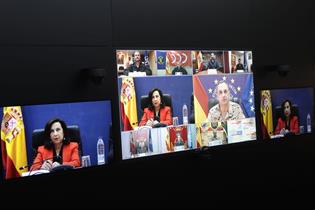 Ministerio de DefensaThe Spanish minister spoke to the leaders of 22 different ground and air detachments, Spanish Navy vessels and UN international peace observers, to whom she conveyed news about the status of their respective missions and the activities currently being carried out in the various parts of the world where they are deployed.
Ministerio de DefensaThe Spanish minister spoke to the leaders of 22 different ground and air detachments, Spanish Navy vessels and UN international peace observers, to whom she conveyed news about the status of their respective missions and the activities currently being carried out in the various parts of the world where they are deployed.
"You are the best of our country, the best representatives of the 'Spain Brand'", said Margarita Robles, who, in response to each one of the contingents, underlined how the Spanish Armed Forces perform their duty "with generosity and love for Spain", with an extra special memory and words of affection for the families of the military servicemen and women deployed overseas.
"Although distant, they are also the closest, because they are the main stars of the parade", said the Spanish minister after recalling that the slogan chosen this year to commemorate the National Day of Spain celebrations is "Committed to Peace" in recognition of the work done over 30 years on overseas missions.
Non official translation





